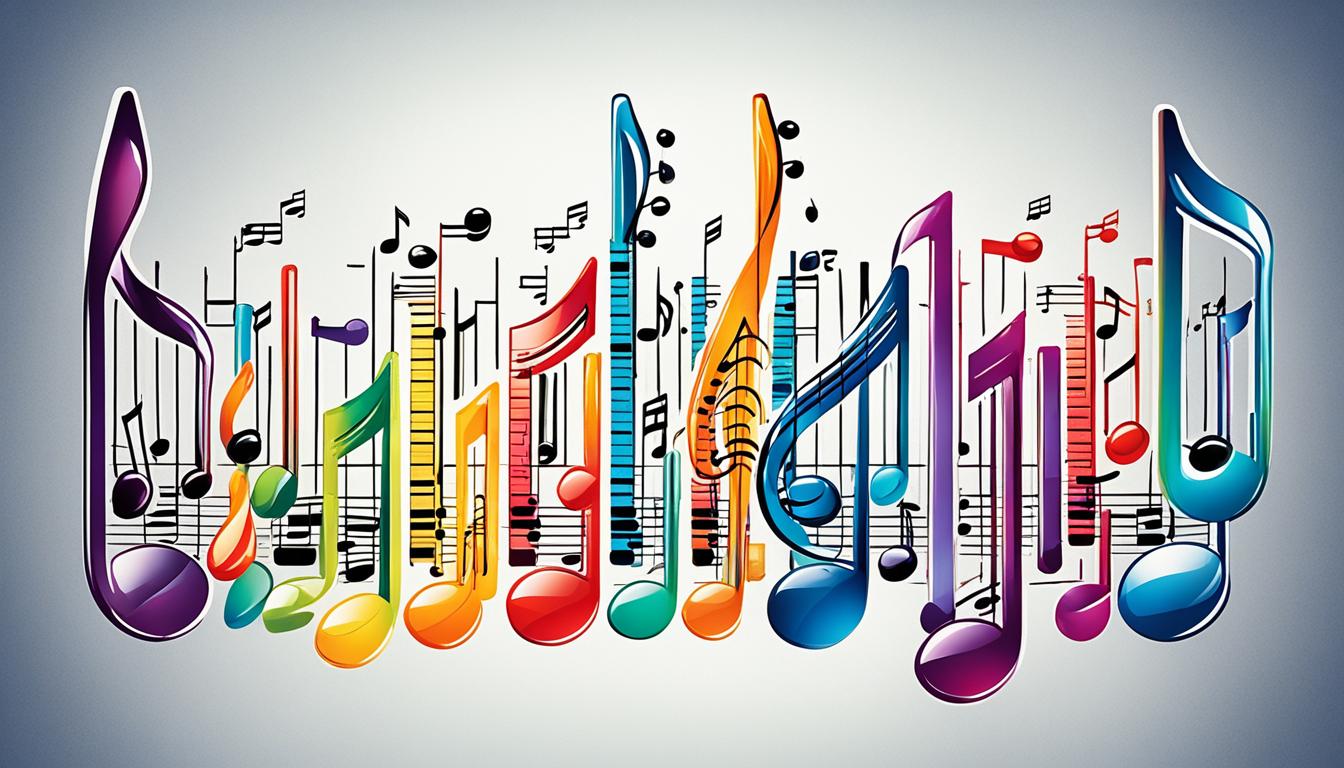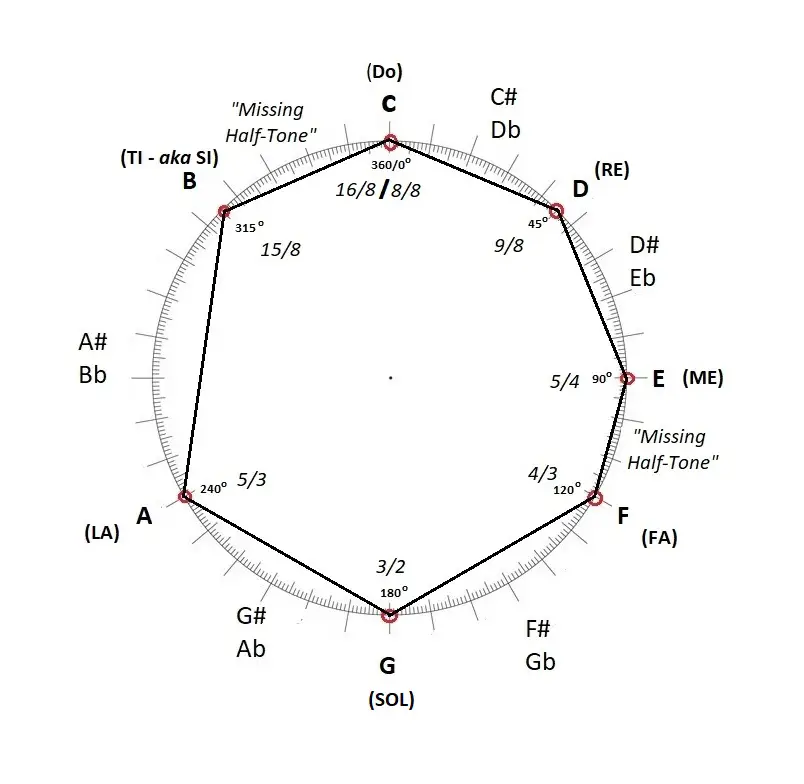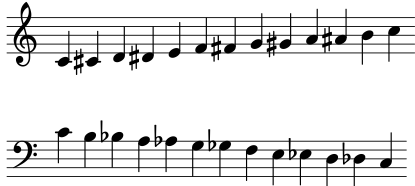
Ever wondered what makes a catchy melody or a powerful chord progression? It all boils down to something called scales, which are like the building blocks of music. But have you heard terms like "diatonic" and "chromatic" thrown around, leaving you scratching your head? Fear not, music lovers! This post is here to clear things up and break down the differences between these two musical scales in a way that's easy to understand. So buckle up, and get ready to demystify the world of diatonic and chromatic scales!

Credit: WikiMedia Commons
Imagine a ladder, but instead of rungs for your feet, it has seven steps for your musical notes. That's kind of what a diatonic scale is like! It's a special arrangement of seven notes that musicians use to create melodies and harmonies.
These seven notes aren't just randomly chosen, though. They have a specific order with five big steps and two small steps between them. Think of the big steps like taking two stairs at once, and the small steps like taking just one. This special pattern creates a certain sound that we often hear in our favorite songs.
There are actually two main types of diatonic scales: major scales and minor scales. Major scales sound bright and happy, like sunshine on a spring day. Minor scales, on the other hand, have a more mysterious or sad feeling, like a rainy afternoon.
But diatonic scales are like musical chameleons! They can be used to create all sorts of different moods and feelings depending on how they're arranged and played. So next time you hear a catchy tune, listen closely and see if you can identify the diatonic scale hiding behind the notes!

Now, imagine throwing out the ladder altogether and instead having a giant slide with twelve evenly spaced bumps. That's kind of like a chromatic scale! It includes all twelve notes of the Western musical system, both the white and black keys on a piano.
Unlike the diatonic scale with its specific steps, the chromatic scale is all about half steps. Each note is just a tiny bit higher or lower than the one next to it. The chromatic scale on its own doesn't really have a specific musical character. It's more like a collection of all the possible notes, waiting to be used in different ways.
Think of it like a box of crayons. The diatonic scale is like picking out a few specific colors to create a picture, while the chromatic scale is like having every single color at your disposal. While the picture might not make sense with just random scribbles, skilled artists can use those extra colors to add details and make their artwork truly unique!

Now that we've met our musical ladders and slides, let's see how diatonic and chromatic scales stack up:
| Feature | Diatonic Scale | Chromatic Scale |
|---|---|---|
| Number of Notes | 7 | 12 |
| Structure | 5 whole steps + 2 half steps in a specific pattern | All 12 notes separated by half steps |
| Musical Function | Foundation for melodies and harmonies | Provides individual notes for adding color and complexity |
As you can see, the main difference lies in the number of notes and their arrangement. Diatonic scales offer a specific structure with distinct intervals, while chromatic scales provide all the possible notes for more intricate exploration.
It's important to remember that chromaticism, the incorporation of chromatic notes into diatonic scales, plays a crucial role in music. Adding these "extra colors" allows musicians to:
Think of it like building with Legos. While the basic bricks (diatonic scales) form the core structure, adding a few different colored pieces (chromatic notes) can introduce unique details and elevate the overall creation.
Scales form the foundation of musical composition, dictating the available notes for melodies and harmonies. They set the tonal framework of a piece, influence the emotional impact, and guide the composer in crafting a coherent musical narrative. Diatonic scales often result in more traditional, harmonious music, while chromatic scales allow for complex and tension-filled compositions.
Not necessarily! While chromaticism can create tension and evoke certain emotions, it can also be used for other purposes. For example, chromatic notes can be used to add smooth melodic transitions, create playful dissonances, or even build anticipation towards a major resolution.
Modes are different scales that can be formed by starting on each note of a diatonic scale. Each mode has a unique sequence of intervals, giving it a distinct sound and mood. For example, the Ionian mode is another name for the major scale, and the Aeolian mode is known as the natural minor scale. Other modes like Dorian, Phrygian, Lydian, Mixolydian, and Locrian offer additional tonal palettes within the diatonic scale framework.
Yes! While diatonic and chromatic scales are fundamental, there are many other types of scales used in music, each with its own unique sound and character. Some examples include the pentatonic scale (used in blues and folk music), the whole tone scale (used in impressionistic music), and the blues scale (used in, you guessed it, blues music!).
Countless pieces across various genres utilize these scales!
Here are a few examples:
Diatonic: Beethoven's "Ode to Joy" (major scale), Bach's "Air on the G String" (minor scale)
Chromatic: Chopin's "Fantaisie-Impromptu" (extensive chromaticism for dramatic effect), Mozart's "Eine Kleine Nachtmusik" (subtle chromaticism for added expression)
Diatonic and chromatic scales might sound fancy, but they're just different ways of organizing musical notes. Diatonic scales are the workhorses, providing the basic building blocks for melodies and harmonies. Chromatic scales, on the other hand, offer a wider range of notes for adding extra flavor and complexity. Remember, both of them play important roles in creating the music we love.
If you found this guide helpful, please consider subscribing to our blog for more music production tips, product reviews, and buying guides. Also, you can support new content by contributing to our tip jar.
"Some of the links within this article are affiliate links. These links are from various companies such as Amazon. This means if you click on any of these links and purchase the item or service, I will receive an affiliate commission. This is at no cost to you and the money gets invested back into Audio Sorcerer LLC."